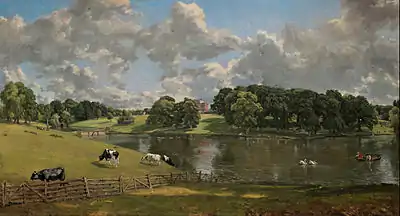پارک ویونهو
پارک ویونهو(به انگلیسی: Wivenhoe Park) یک نقاشی از منظره پارک انگلیسی ، از املاک خانواده ربو است که توسط نقاش رمانتیک انگلیسی جان کانستبل (۱۷۷۶–۱۸۳۷)کشیده شدهاست.[1][2]
 | |
| هنرمند | جان کانستبل |
|---|---|
| سال | ۱۸۱۶ |
| گونه | رنگ روغن روی بوم |
| ابعاد | ۵۶٫۱ cm × ۱۰۱٫۲ cm (۲۲٫۱ in × ۳۹٫۸ in) |
| مکان | نگارخانه ملی هنر آمریکا، واشینگتن، دی.سی.، ایالات متحده آمریکا |
جان کانستبل در اسکس متولد شد؛ او بیشتر به خاطر نقاشی مناظر، بهویژه مناظر روستایی که کودکیش را آنجا گذراند شناخته شدهاست. نقاشیهای او اکنون جزو باارزشترین و محبوبترین نقاشیهای هنر بریتانیا است.[3][4]
نقاشی
نگارخانه ملی از این نقاشی به عنوان یکی از کارهای برجستهاش یاد میکند:[3]
صحنه دلپذیری از سادگی و هماهنگی که موجب می گردد این منظره تقریباً وضوح و روشنی یک عکس را داشته باشد. نواحی زیادی از تابش آفتاب و سایه خنک، خط طولانی پرچین، تعادل زیبای درختان، چمنزار، و رودخانه مدرکی بر ترکیب خلاقانه هنرمند از مکان واقعی است.
مالک پارک ویونهو-که از حامیان اولیه هنرمند و از دوستان نزدیک پدر او گلدینگ کانستبل بود- سفارش نقاشی را داد.پارک ویونهو ۲۰۰ هکتار زمین مناسب پارک است،که قبل از ۱۷۳۴ به وسیلهٔ خانواده ربو خریداری شد.[5][6]
در سال ۱۸۱۲ اسلتر ریبو چندین نقاشی از جمله پرتره دختر هفت ساله اش را به کانستبل سفارش داد. تصویر او نیز در این نقاشی روی ارابه ای که الاغی آن را می کشد در قسمت چپ تابلو دیده میشود. این نقاشی در سپتامبر سال ۱۸۱۶ تمام شد و پول کافی برای ازدواج با عشق طولانی مدتش، مری بیکنل را فراهم کرد. آنها در اکتبر ۱۸۸۱۶ ازدواج کردند.[3][7]
رسانه
 | |
منابع
- "permanent_collection_john_constable". dcist.com. Archived from the original on ۷ مه ۲۰۱۵. Retrieved November 2014. Check date values in:
|accessdate=(help) - [“No two days are alike, nor even two hours; neither was there ever two leaves of tree alike since the creation of the world.” So said John Constable (1776–1837), regarded by many as England’s greatest landscape painter. His work Wivenhoe Park, Essex (1816) at the National Gallery of Art vibrates with the verdant essence of the countryside. Constable’s studies, sketchbooks and paintings all reveal the profound connection he felt to the landscapes of his native Suffolk and the surrounding counties. Quote from Aleid Ford's project, Art 2010, for DCist online magazine for the Washington DC USA area. Ford is a staff member of DCist.]
- Collection Highlights. "Wivenhoe Park, Essex". nga.gov. National Gallery of Art. Archived from the original on 5 October 2014. Retrieved 22 November 2014.
- [Major-General Rebow, a friend of Constable’s father, commissioned the artist to capture the beauty of his estate, inviting him to spend some weeks on the premises. General Rebow specified that certain features be included in the painting. Constable arranged these harmoniously, modifying the actual location of certain elements (for example, the house and lake were not actually part of the same view). Typically, the owner of such a house might wish for a more grandiose portrait of it, but Constable preferred the everyday poetry of landscape and sky.Quote from Aleid Ford's project, Art 2010.]
- Marsden, Pat. "Wivenhoe House: A Tale of Two Lost 18th Century Mansions and the Sea-Captains who Built Them" (PDF). Wivenhoe Encyclopedia. Eugene Kraft. Retrieved 22 November 2014.
- "Guide to Colchester Campus". essex.ac.uk. Essex University. Archived from the original on 7 October 2014. Retrieved 22 November 2014.
- [The painting was a important project for Constable on a personal level: He needed the income the commission generated in order to provide for his longtime love, Maria Bicknell, and enable them to marry with the approval of her parents, who opposed the match for a number of years. Wivenhoe Park, Essex was finished by September 1816, and Bicknell and Constable were at last married on October 2, 1816. Quote from Aleid Ford's project, Art 2010.]